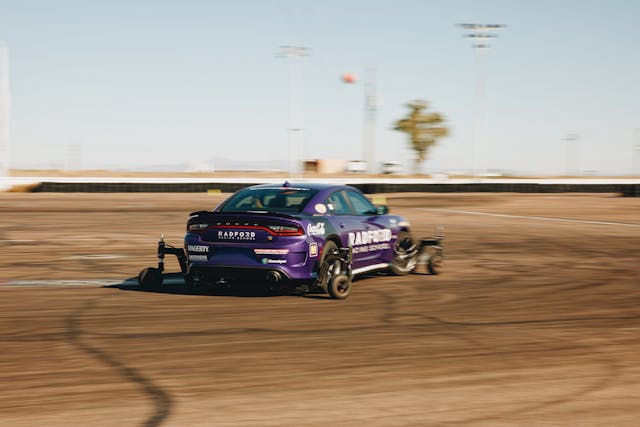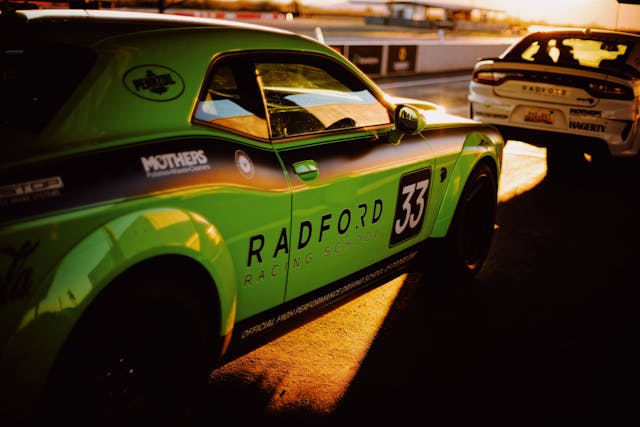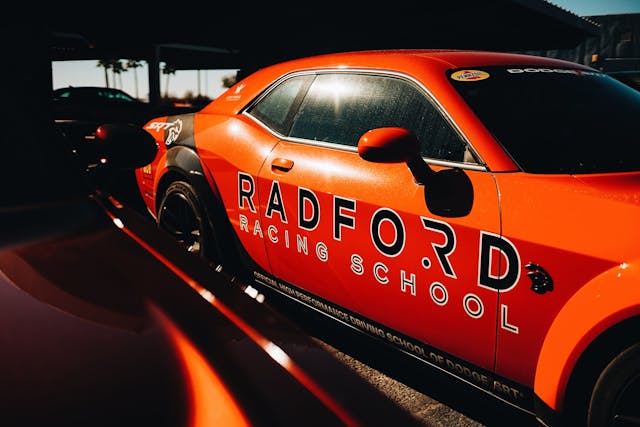How Radford Racing School Sharpens Your Driving Skills
I’ve stormed down the Mulsanne Straight at Le Mans, taken laps at Sebring, and clipped apexes at Lime Rock, Virginia International Raceway, and Road America. Almost all of this heroic driving was in… minivans. As an automotive magazine art director, the job of piloting a Town & Country around raceways—at lofty speeds of 25 or 35 mph—while a photographer hangs out the open hatch, clicking away at a pretty car behind, usually falls to me. Directions inevitably crackle over the radio: “Let’s follow the racing line for a couple laps.” Back in the paddock, my boss strolls over with a cocked eyebrow, claps me on the shoulder, and quietly says “Todd, that was not the racing line. But nice try!”
Eventually, the boss man decided I needed some professional instruction, so I headed to Chandler, Arizona, just a few miles from the Phoenix airport, for the two-day High Performance Driving course at Radford Racing School. Radford is the former Bondurant Racing School, and while the name and ownership have changed, the curriculum still is firmly based on the instructional philosophy that Bob Bondurant originally implemented in 1968. Some of the older instructors worked for decades under Bondurant’s guidance and are very proud of that heritage. From the moment you enter the classroom for orientation, you feel like you’re in the absolute best hands.



Radford offers programs for all levels of drivers and aspiring racers alike. I was placed in the Performance Street Driving class, which is about 75 percent aimed at street driving, with the rest dedicated to track-driving basics. Radford also offers programs for advanced racers, Formula 4/open wheel, drag racing, and even karting and teen driving instruction.
Like every driving school, Radford begins instruction in the classroom. My classmates were two amateur racers refreshing their skills and a mother-and-daughter team. Mom had taken the same course before and now wanted her daughter to benefit from the same training. Classes are kept small to retain a 3:1 student-to-instructor ratio. After a brief history of the school from chief instructor Danny Bullock, we were given the outline of our course: car control and vehicle dynamics training, accident avoidance and safety techniques, and track driving fundamentals. About 80 percent of the course is spent behind the wheel, out on the track. First, though, we learned some academic basics.
Performance driving, we learned, is all about weight management. Acceleration shifts weight to the back of the car; braking moves it to the front. Simple, but key to everything we’d be doing. Also essential: Always be looking ahead—a longer distance in front of you, not just at the hood of the car. Several of our on-track exercises were built to practice these two concepts. For example, the slalom helped us learn to keep our weight balance even, while the “go, lift, squeeze” exercise helped us look far ahead without automatically slamming hard on the brakes. The point is that even in a full accident-avoidance situation, looking ahead will have you braking and turning earlier to avoid the crash.
With the preliminaries done, it was time to get fitted for a helmet and head out to the course. Radford partners with Dodge SRT, so we were given Dodge Challenger SRT Hellcats. I chose to drive a manual transmission, which put me in a maroon 392 Scat Pack edition Challenger instead. I really appreciated that I was in the same car for the entire school, so I could set all the seating and other adjustments to my liking and have them dialed in every time I got in.

First up were the braking exercises. For the first few, the objective was not to touch the brakes at all. The paddock was lined with cones, making a three-lane roadway scenario. Above each lane was an instructor-controlled traffic light. Red and green. Our challenge was to accelerate to a set speed, which increased after each stage was complete. As we approached the point where the three-lane split emerged, the instructor would light only one path green. The driver was to lift, abruptly turn into the only available path, hit the gas again and drive through. This obviously got harder as the speed increased with each pass, but it really gets you in touch with the vehicle’s weight balance. Avoidance, without braking.

Then came some exercises employing that middle pedal. Cones were rearranged and we set off at the same three traffic lights, this time applying the brakes after the lane switch to stop within a predetermined “cone box” built on one side or the other. This, too, was a level-up challenge as the approaching speed increased. Initial exercises were done without initiating a full-on ABS stop.
This graduated to the final task of the morning, hurtling the Challenger toward a line of cones, with a braking point marked. Success was measured here in being able to stop the car with the nose just at the cone line. I really got a feel for how the car’s weight shifts, and the brake pedal pressure needed. The last few runs were full anti-lock pedal mashes as we sped toward the cone wall. It was both exhilarating and nerve-wracking.

The afternoon of Day One was for drifting. This was the only time we used a car other than the one assigned to us for our course. This unique Challenger was set up with wheels attached to a metal frame built outside the car. These were controlled by a computer with switches and levers on a control box inside the vehicle. This way, the instructor could adjust the amount of “slidability” the car would have.



I was fairly intimidated by this exercise, imagining myself in infinite 360 spins all over the paddock. As I got behind the wheel, instructor Spencer Buckman took me through the apex points where I was to slide and control by opposite steering through a figure-eight setup. My nervousness faded quickly as I slid the car around the paddock. The instructor explained how the different settings he was applying were changing the performance of the car as we modified the direction and speed. Damn, that was a lot of fun. Drifting distilled is merely weight transfer control. Who knew?
Day Two: After a bit more classroom briefing, we headed out to the 1.6-mile raceway. Spencer gave us a track tour in a Charger SRT, carefully explaining the art of corner apexes and the all-important racing line. Then we got to put our new cornering knowledge, and the skills we’d practiced the day before, to use on the Maricopa Oval. It was a perfect space to lap and test two corners, finding the apex point and accelerating out of the turn as we continued to the next.

Finally, I had learned the elusive racing line and was gaining confidence as I picked up speed working this section of track for an hour. Stops to evaluate were encouraged, as were moments to just catch your breath. Spencer would often jump in the car with us, sometimes taking the wheel or riding along as a passenger and providing encouraging feedback.
Then we did a lead-follow exercise on the entire raceway, all 15 turns of it, at a controlled speed. What an exciting experience to just take lap after lap in the Arizona sun in a great performance car with fresh skills.



My program at Radford culminated in the slalom. Back on the paddock, an autocross course was laid out. Spencer took us on practice runs through the tight series of turns, first in a leisurely manner, and then at full chat, flicking the SRT Charger here and there effortlessly. The first few student-driven laps were practice. Getting a good feel for the layout. The corners. The braking points. Gradually building up speed.
Then, the instructors’ stopwatches came out. Timed runs. I’d done well after I’d settled down in the practice sessions, but being timed brought out the competitor in me. It was a challenge to stay focused and not try to manhandle the Dodge around the course. I couldn’t find a smooth path through a hairpin corner: It was either too much brake on the approach or… not nearly enough. Both slowed me down. Focus. The younger woman of the family pair in my class had it on lock. She continuously made great times, shaving a few seconds off every run. Kudos, miss.

The slalom was a great aggregator for all we’d been taught. Our course was not really about racing, but simply making us better road drivers. Valuable skills, whether you’re a teen or a seasoned racer.
Radford was an exciting, super-informative experience, one every driver should have. Once home, I was proud to apply my gold “High Performance Driving Graduate” sticker to the window of my Focus ST. A shiny reminder of two days spent meeting great people and the unadulterated fun I had on that raceway in the desert, with not a single minivan in sight.















***
Check out the Hagerty Media homepage so you don’t miss a single story, or better yet, bookmark it. To get our best stories delivered right to your inbox, subscribe to our newsletters.


